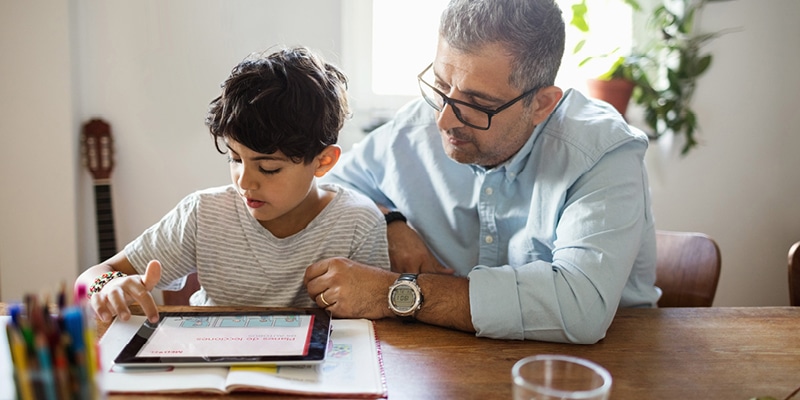MED-EL
Published Aug 17, 2022
Providing Aural Rehabilitation to Recipients in Another Language

It is vital that caregivers provide rich, abundant language models to their children from an early age, as this has a positive impact on a child’s communication, cognitive, social, and emotional development.[1] Hence, family members of children with hearing implants pursuing spoken communication are encouraged to speak to their child in the language or languages that the family members speak fluently. Each family member speaking their ‘home language(s)’ or ‘native language(s)’ facilitates the family’s ability to provide a rich, abundant language environment, and promote social connection within the family.[4]
But what if children with hearing implants live in a home or region where more than one language is frequently spoken? What if the family’s native language is different to that of the region they live and the language of education? And what if the family’s native language is different to that of the rehabilitation professional?
Determining the Intervention Language for Aural Rehabilitation
Providing family-centered intervention early is paramount. This involves developing partnerships with families to promote the best outcomes, which is the best practice in pediatric cochlear implant rehabilitation. Linguistically diverse families require individualized support. These families’ “distinctive nature such as their culture, beliefs, values, emotions, coping skills, and family dynamics” must be taken into consideration so that aural rehabilitation “promotes linguistic accessibility and home languages.”[3]
The language used in intervention will depend on numerous factors including:
- The family’s language use and proficiency
- The child’s dominant language (if they show clear language dominance)
- The family’s goals for their child’s language learning
- The child’s language environments
- The majority language of education
- If the child is a simultaneous or sequential bilingual language learner
- If the child’s family is bilingual (including fluent proficiency in the majority language of education) or monolingual other-language-speaking.[4]
- The child’s age and current level of skills.
Providing Aural Rehabilitation in a Language the Rehab Professional Doesn’t Speak
Engaging interpreters or the support of a trained therapy assistant who speaks the families’ home language proficiently is essential when working with families who speak languages other than those shared by the rehabilitation professional. Doing so will ensure the family’s equitable access to intervention and information.
Using bilingual therapy materials is one technique that allows rehabilitation professionals to facilitate families to practice strategies in their home language. For example, while working with a Russian-speaking family, a therapist may explain an activity (such as the story from Lesson Kit 17 Sharks and Whales) and a strategy (e.g., acoustic highlighting) via the interpreter, using the story in English and in Russian. The therapist may demonstrate a page of the story in English and the strategy while the parent observes and looks on with the same story in Russian. Then the parent continues the story in Russian, with coaching and feedback from the therapist via the interpreter or bilingual therapy assistant.
Example 1: A Russian-Speaking Family & an English-Speaking Therapist
Attendees: Therapist (English speaking only), Parent and Child (Russian speaking only), Interpreter (English, Russian). The interpreter interprets all conversation for the parent and therapist.
- Therapist explains the activity (story) and strategy (acoustic highlighting).
- Interpreter interprets into Russian.
- The therapist demonstrates reading a page of the story using acoustic highlighting. The parent observes and looks on at the same story in Russian.
- Interpreter interprets into Russian also using acoustic highlighting. The parent observes and looks on at the same story in Russian.
- The therapist repeats and answers parents’ questions if needed.
- The therapist hands over the task to the parent. The parent reads the same page of the story to their child using the storybook in Russian.
- The parent reads a page and uses acoustic highlighting in Russian with their child. Therapist observes.
- Interpreter interprets into English.
- The therapist provides guidance and coaching to the parent to continue and to adapt their behavior to best support their child.
- Interpreter interprets guidance and coaching into Russian.
Example 2: A Polish-Speaking Family & an English-Speaking Therapist
Attendees: Therapist (English speaking only), Parent and Child (Native Polish speaking, Parents have limited English proficiency), Interpreter (English, Polish). The interpreter interprets all conversation for the parent and therapist.
- Therapist explains the strategy of using waiting and modeling to encourage the child’s vocalizations. The therapist explains they will practice this strategy with bubbles.
- The interpreter interprets into Polish for the parent.
- The therapist identifies key words in the play sequence; ‘bubbles’, ‘open’, ‘more’, ‘pop’, and asks the parent for appropriate Polish words to use in this context.
- The interpreter interprets this in Polish for the parent to offer suggestions that they feel are appropriate.
- The therapist demonstrates using waiting and modeling with the bubbles in English. The therapist may look to the parent to have them use the key words in Polish during the activity e.g., the therapist says, “We have to open the bubbles, open,” and looks to the parent to say “open” in Polish.
- The interpreter interprets for the parent.
- The therapist hands the bubbles over to the parent for them to practice using waiting and modeling to encourage their child’s vocalizations in Polish.
- Interpreter interprets into English.
- The therapist provides guidance and coaching to the parent to continue and to adapt their behavior to best support their child.
- Interpreter interprets guidance and coaching into Polish.
In both scenarios, the therapist will demonstrate an activity in English, but the aim is for the parent to be interacting with their child and to be practicing the activity, strategy, and targeting the child’s goals in their native language.
Multilingual and Bilingual Cochlear Implant Recipients
The above scenarios describe situations in which one language can be considered the child’s native language; however, it is increasingly common that families speak more than one language, or children spend considerable time in other language environments that differ from the families’ home language(s). Current research demonstrates that learning more than one language is achievable for children using hearing implants.[6,7,8] In fact, research has shown that bilingual children with cochlear implants can achieve language skills similar to that of monolingual children with cochlear implants.[5]
Cochlear Implant Rehabilitation Materials in Languages Other Than English
There is a wealth of MED-EL rehabilitation resources available in multiple languages for free download to assist you in providing early intervention to children with hearing loss and their families. If you are looking for therapy materials in languages other than English, we have listed some resources below to take a look at. All are available for free download and can be used in the therapy room or as activities for families to use on their own at home.
MED-EL Lesson Kit 1 is available in 13 languages and contains printable therapy activities including a storybook, game, and craft. This kit is now available in all of the following languages:
- English
- French
- Spanish [Latin America]
- Portuguese [Brazil]
- German
- Russian
- Indonesian
- Italian
- Mandarin Chinese
- Polish
- Romanian
- Korean
- Georgian
There are 26 other Lesson Kits available here on the MED-EL Professionals Blog in English on various topics, many of which are translated into additional languages.
Additional Materials to Improve Language Skills in Languages Other Than English
The Murat Reader Series consists of four stories, developed to support caregivers to take part in shared book reading with their children. Caregiver guidance on each page offers suggestions for talking points and ideas for follow-up activities to encourage caregivers to extend the topic of the story through play to continue to develop their child’s vocabulary and language skills. The series is available in English, German, Bulgarian, Turkish, and Polish. Scroll down the MED-EL Rehabilitation Downloads page to find the Murat Reader Series, then select the language you wish to view from the drop down menu.
The LittlEARS® Diary Activities include step-by-step instructions for 28 activities for families to practice listening and language skills with their young child in the home environment. This resource is available in 11 languages: English, German, Turkish, Hindi, Russian, French [Canada], Arabic, Mandarin, Spanish [Latin America], Polish, and Georgian. Scroll down the MED-EL Rehabilitation Downloads page to find the LittleEARS Diary Activities, then select the language you wish to download from the drop down menu.
Special thanks to Natalie Teakle, Advanced Rehabilitation Manager at MED-EL, and Michael Douglas, Consumer Engagement Program Manager at MED-EL, for writing and contributing to this article.
Subscribe & Share
If you find our articles like these helpful, be sure to subscribe to receive links to new articles and rehabilitation kits directly in your inbox as soon as they are released. Also, don’t forget to share this with your colleagues or friends who might also enjoy this material.
References
- Gilkerson, J., Richards, J. A., Warren, S. F., Oller, D. K., Russo, R., & Vohr, B. (2018). Language experience in the second year of life and language outcomes in late childhood. Pediatrics, 142(4). https://doi.org/10.1542/peds.2017-4276
- Mendelsohn, A., & Klass, P (2018). Early language exposure and middle school language and IQ. Pediatrics, 142 (4). https://doi.org/10.1542/peds.2018-2234
- Moeller, M. P., Carr, G., Seaver, L., Stredler-Brown, A., & Holzinger, D. (2013). Best practices in family-centered early intervention for children who are deaf or hard of hearing: an international consensus statement. Journal of Deaf Studies and Deaf Education, 18(4), 429–445. https://doi.org/10.1093/deafed/ent034
- Douglas, M. (2014) Dual-Language Learning for Children with Hearing Loss: Assessment, Intervention and Program Development. Durham, USA: MED-EL Medical Electronics.
- Yorgancılar, A. E., & Sizer, B. (2022). Evaluation of the language development of children with cochlear implant users living in a multilingual environment. International Journal of Pediatric Otorhinolaryngology, 152, 111007. https://doi.org/10.1016/j.ijporl.2021.111007
- Bunta, F., & Douglas, M. (2013). The effects of dual-language support on the language skills of bilingual children with hearing loss who use listening devices relative to their monolingual peers. https://doi.org/10.1044/0161-1461(2013/12-0073)
- Waltzman, S. B., Robbins, A. M., Green, J. E., & Cohen, N. L. (2003). Second oral language capabilities in children with cochlear implants. Otology & Neurotology, 24(5), 757-763.
- Guiberson M. (2014). Bilingual skills of deaf/hard of hearing children from Spain. Cochlear implants international, 15(2), 87–92. https://doi.org/10.1179/1754762813Y.0000000058
MED-EL
Was this article helpful?
Thanks for your feedback.
Sign up for newsletter below for more.
Thanks for your feedback.
Please leave your message below.
CTA Form Success Message
Send us a message
Field is required
John Doe
Field is required
name@mail.com
Field is required
What do you think?
MED-EL



